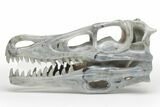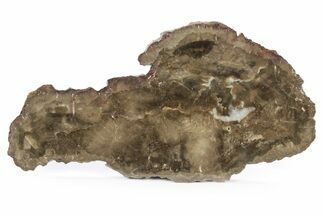This Specimen has been sold.
9.8" Carved Labradorite Dinosaur Skull - Roar!
As if raptors weren't already mind-bogglingly awesome enough, we decided to add a whole other layer of intrigue and fantasy. This is a wild piece that is sure to excite any collector and is destined to be the envy of your social circle. What we have for you is an exquisitely-crafted, polished, 9.8" long raptor skull that's meticulously carved from labradorite. The brilliant orange, blue, green, and gold labradoresent colors dance in the light, giving this specimen an entirely different personality when viewed from different angles and lighting.
The opportunity to own a replica dinosaur skull is now easier than you could have imagined, and you can do it in style. This skull is insanely snazzy and easily looks at home in both an Indiana Jones film and on your mantle. An overall fun piece for the casual enthusiast or anyone that enjoys really cool display pieces. A jaw-snapping good time!
The opportunity to own a replica dinosaur skull is now easier than you could have imagined, and you can do it in style. This skull is insanely snazzy and easily looks at home in both an Indiana Jones film and on your mantle. An overall fun piece for the casual enthusiast or anyone that enjoys really cool display pieces. A jaw-snapping good time!
About Labradorite
Labradorite is a feldspar mineral most often found in mafic igneous rocks. Some specimens of labradorite exhibit what is called a "Schiller effect"; a strong play of iridescent blue, green, red, orange, and yellow colors. Labradorite is so well known for these spectacular displays of color that the phenomenon is also known as labradorescence. Specimens with high quality labradorescence are often polished and used as gemstones.
The labradorescence is not caused by the colors breflecting on the surface of the specimen. Instead, light enters the stone, hits a twinning crystal lattice surface within the stone, and reflects from that. The color seen is the color of light reflected from that twinning surface. Different twinning surfaces within the stone reflect different colors of light. Light reflecting from different twinning surfaces in various parts of the stone can give the stone a multi-colored appearance.
Labradorite is named after Labrador, Canada, where it was first found. Today, the most prolific deposits for most commercially available labradorite occur in Madagascar and Russia.
Labradorite is a feldspar mineral most often found in mafic igneous rocks. Some specimens of labradorite exhibit what is called a "Schiller effect"; a strong play of iridescent blue, green, red, orange, and yellow colors. Labradorite is so well known for these spectacular displays of color that the phenomenon is also known as labradorescence. Specimens with high quality labradorescence are often polished and used as gemstones.
The labradorescence is not caused by the colors breflecting on the surface of the specimen. Instead, light enters the stone, hits a twinning crystal lattice surface within the stone, and reflects from that. The color seen is the color of light reflected from that twinning surface. Different twinning surfaces within the stone reflect different colors of light. Light reflecting from different twinning surfaces in various parts of the stone can give the stone a multi-colored appearance.
Labradorite is named after Labrador, Canada, where it was first found. Today, the most prolific deposits for most commercially available labradorite occur in Madagascar and Russia.
 Reviews
Reviews


















